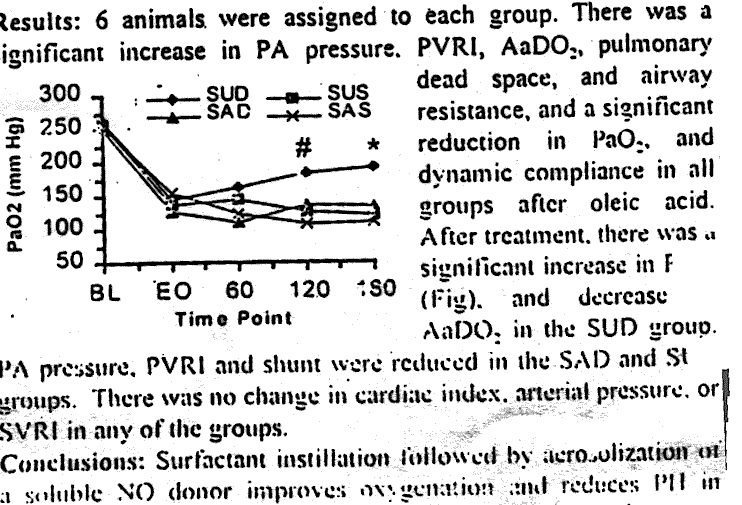
| 11 th Annual Pediatric Critical Care Colloquium |
| Session/Time | Pulmonary II/Thu, 2:00 - 4: 00 PM |
| Title | Soluble NO Donor and Surfactant Improve Oxygenation and Pulmonary Hypertension (PR) in Porcine Acute Lung Injury |
| Author | B Jacobs, R Brilli, D Smith, D Passerini |
| Affiliation | Division of Critical Care Medicine, Children's Hospital Medical Center, Cincinnati, Ohio, and Department of Chemistry, University of Akron, Ohio |
| Introduction | Acute lung injury (ALI) is associated with injury to the alveolar- capillary unit, with widespread non-uniform lung injury, pulmonary edema, diminished surfactant activity, and PH. lnlialed nitric oxide (NO) reduces PH, improves oxygenation, cintrapulmonary shunt fraction, and improves ventilation/perfusion matching in ALI. NO when combined with nucleophile a class of NO donors (NONOates) which are stable as solids under-o spontaneous release of NO in solution. We previously reported that intratracheal administration of the NONOate (dimethylamino) ethyiputreanine/NO (DMAEPINO) results in selective reduction in PH, and improved oxygenation. Surfactant, when combined with DMAEPINO, may allow enhanced delivery to the alveolar recion while at die same time takinc, advantage the additive or synergistic pharmacoloic properties of each acent. We hypothesized that the delivery of aerosolized F would be facilitated by surfactant, resulting in syncroistic improvements in oxygenation and PH in a porcine model of oleic acid-induced ALI. |
| Method | Pigs (13.4±0.4 kg) were anesthetized and mechanically ventilated. A median stemotomy was performed and catheters placed in the PA, LA, and RA. A flow probe was placed around the PA. Following stabilization, oleic acid was given IV into the femoral vein over I hr to achieve a PVRI 2-3 fold greater than baseline and a PaO, 100-150 torr while on an FiO, of 0.5. Arterial and mixed venous blood aas tensions were determined throughout the experiment. Pulmonary measurements were made with a pulmonary function monitor. Animals were randomly assioned to I of 4 -roups: Surfactant-Salirie (SUS), Surfactant-DMAEP/NO (SUD), Saline-Saline (SAS), or Saline-iDMAEPINO (SAD). Saline, or surfactant (2 cclk-) was instilled into the trachea over minutes. Gas exchange, pulmonary function, and hemodynamic data were collected for I hr. DMAEP/NO (100 mg/2cc aline) or saline (2cc) solutions were nebulized over 5 mins, and data collected for 2 hrs. |
| Result |  |
| Conclustions | Surfactant instillation followed by aerosolization of a soluble NO donor improves oxygenation and reduces PH in porcine ALL. Intermittent aerosolization of soluble NO donors. |
Use your browser's back button to return to the appropriate index of abstracts...
Back to PCCC 98 Abstract Introduction | Back to PCCC 1998
Document created April 12, 1999